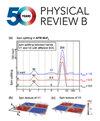Integrable and critical Haagerup spin chains
IF 3.7
2区 物理与天体物理
Q1 Physics and Astronomy
引用次数: 0
Abstract
We construct the first integrable models based on the Haagerup fusion category H3. We introduce a Haagerup version of the anyonic spin chain and use the boost operator formalism to identify two integrable Hamiltonians of PXP type on this chain. The first of these is an analog of the golden chain; it has a topological symmetry based on可积临界Haagerup自旋链
我们基于Haagerup融合范畴H3构造了第一个可积模型。我们引入了任意子自旋链的一个Haagerup版本,并利用升压算子形式确定了该链上的两个PXP型可积哈密顿量。第一种是类似金链的东西;它具有基于H3的拓扑对称性,满足参数δ=(3+13)/2的Temperley-Lieb代数。利用Lax形式证明了其可积性,并构造了Yang-Baxter方程的相应解。给出了该模型具有动态临界指数z≠1的无间隙性的数值证据。我们发现的第二个可积模型打破了拓扑对称性。我们提出了数值证据,表明该模型在具有中心电荷c ~ 3/2的大体积限制下简化为CFT。2025年由美国物理学会出版
本文章由计算机程序翻译,如有差异,请以英文原文为准。
求助全文
约1分钟内获得全文
求助全文
来源期刊

Physical Review B
物理-物理:凝聚态物理
CiteScore
6.70
自引率
32.40%
发文量
0
审稿时长
3.0 months
期刊介绍:
Physical Review B (PRB) is the world’s largest dedicated physics journal, publishing approximately 100 new, high-quality papers each week. The most highly cited journal in condensed matter physics, PRB provides outstanding depth and breadth of coverage, combined with unrivaled context and background for ongoing research by scientists worldwide.
PRB covers the full range of condensed matter, materials physics, and related subfields, including:
-Structure and phase transitions
-Ferroelectrics and multiferroics
-Disordered systems and alloys
-Magnetism
-Superconductivity
-Electronic structure, photonics, and metamaterials
-Semiconductors and mesoscopic systems
-Surfaces, nanoscience, and two-dimensional materials
-Topological states of matter
 求助内容:
求助内容: 应助结果提醒方式:
应助结果提醒方式:


